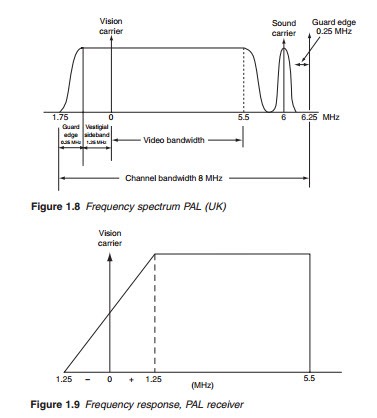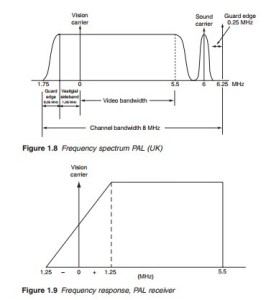Television broadcasting
There are three methods of television broadcasting: terrestrial, satellite and cable. Each method may be used to broadcast analogue or digital TV programmes. Terrestrial is the traditional method of broadcasting television sig- nals to the home employing UHF radio frequencies (400–800 MHz). Satellite broadcasting involves two stages. In the first place, the TV signals are sent to a satellite stationed at a distance of 35,765 km above the equator. The satellite sends these signals back to earth (on a different frequency) and they may be received using a simple satellite dish aerial. Cable broadcasting, as the name implies, uses a transmission cable to send TV signals to home sub- scribers. Let’s first start with analogue terrestrial transmission.
Modulation
A variety of modulation techniques are used in TV broadcasting including amplitude modulation (AM) and frequency modulation (FM) are used in analogue terrestrial broadcasting, FM and quadrature phase shift keying (QPSK) in digital satellite broadcasting, quadrature amplitude modula- tion (QAM) and orthogonal frequency division multiplex (OFDM) in dig- ital terrestrial television (DTTV) and digital audio broadcasting (DAB). Pulse code modulation (PCM) is also employed at both the transmitting and receiving ends. For analogue monochrome television, only two types are used: AM for video and FM for sound. For detailed explanation of amplitude and FM, refer to Appendix 8.
Terrestrial TV broadcasting uses AM for the video information. As described in Appendix 8, ordinary AM gives rise to two sets of sidebands on either side of the carrier, thus doubling the bandwidth requirement for the transmission. However, since each sideband contains the same video information, it is possible to suppress one sideband completely, employ- ing what is known as single-sideband (SSB) transmission. However, pure SSB transmission demands a more complicated synchronous detector at the receiving end, making the receiver more expensive. The simple and cheap diode detector which is adequate for double-sideband (DSB) a.m. transmissions introduces a distortion known as quadrature distortion when used to demodulate a SSB AM transmission. This distortion is caused mainly by the lower end of the video frequency spectrum. To avoid this and still use the diode detector, a mixture of SSB and DSB modulation is employed, known as vestigial sideband transmission. In vestigial side- band modulation, DSB transmission is used for low video frequencies and SSB transmission for higher video frequencies.
Frequency spectrum, PAL channel
The frequency spectrum of vestigial sideband transmission used in the UK is shown in Figure 1.8, in which up to 1.25 MHz of the lower sideband is transmitted with the unsuppressed upper sideband.
As well as the composite video, it is also necessary to transmit a sound signal. Traditionally, only mono sound was broadcast using FM. A separate 6 MHz carrier with a bandwidth of 50 kHz (a deviation of ± 25 kHz) is used. The 6 MHz carrier was chosen to fall just outside the highest trans- mitted video frequency (Figure 1.8) to avoid any inter-carrier interference. For instance, for a vision carrier of 510 MHz, the sound carrier is 510 + 6 = 516 MHz.
It can be seen from Figure 1.8 that the frequency response remains constant over the range of video frequencies up to 5.5 MHz on the upper side- band and 1.25 MHz on the lower sideband. Above 5.5 MHz, a steep attenuation takes place to ensure that no video information remains beyond 6 MHz; this prevents any overlap with the sound information. An additional 0.25 MHz is introduced to accommodate the 50 kHz sound band- width and to provide a buffer space for the adjacent channel known as channel ‘guard edge’. Similar attenuation is necessary at the lower sideband for frequencies extending beyond 1.25 MHz with a 0.25 MHz ‘guard edge’ to prevent any overlap with an adjacent channel on the other side. Gradual attenuation is necessary since it is not possible to have filters with instantaneous cut-off characteristics. Adding all of these frequencies together, we end up with an 8 MHz (1.75 + 6.25) bandwidth for a TV channel.
As a consequence of vestigial sideband transmission, video frequencies up to 1.25 MHz are present in both sidebands and frequencies above 1.25 MHz are present in one sideband only. When detected by a simple diode detector, the frequencies below 1.25 MHz will produce twice the out- put of the frequencies above 1.25 MHz. To compensate for this, it is necessary to shape the frequency response of the receiver so that frequencies that are present in both sidebands are afforded less amplification than those present in one sideband only. Such a response curve is shown in Figure 1.9.

